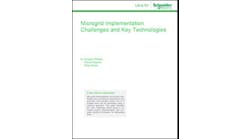FERC Tariff Approvals Open Way for Energy Storage in Wholesale Markets
US regulators gave energy storage a boost with recent approvals of tariffs filed by grid operators that create standardized ways of offering the resource to wholesale markets.
“The tariffs improve prospects for storage by clarifying and standardizing the rules under which it participates, and tell market operators they need to accommodate storage,” said Judah Rose, executive director of the consulting firm ICF.
Approved for some grid operators in late October and others last week, the tariffs are a response to a previous Federal Energy Regulatory Commission (FERC) order seeking fair treatment of energy storage in wholesale markets.
Rose said that the tariffs will provide important economies of scale and efficiencies. No longer will storage proposals be examined on a case-by-case basis, or by each grid operator independently, but by following a set of guidelines established by FERC.
“FERC is streamlining the approval process for storage to participate in markets consistent with the technological ability of the equipment to participate,” said Rose.
What led to tariffs
The issue dates back to 2016, when FERC opened a docket (AD16-20) to review the role of storage for grid operators — independent system operators (ISOs) and regional tranmission organizations (RTOs). After a technical conference and comments from market participants, FERC in February 2018 issued Order 841, asking the ISOs to revise their tariffs so that battery storage could participate in all markets — energy, capacity and ancillary services, explained George Katsigiannakis, vice president of wholesale power markets, ICF.
“FERC said, ‘Here are a bunch of requirements we want organized markets to adopt in their tariffs’ and left it up to the organized markets to design their own models,” said Jennifer Mersing, of counsel, Stoel Rives. Each ISO had to prepare for FERC a filing about how to implement Order 841 in its market.
In late October, FERC approved filings from PJM Interconnection and Southwest Power Pool, subject to small changes. Last week, FERC approved filings from the California Independent System Operator, the Midcontinent Independent System Operator, ISO New England and New York ISO.
End of the rainbow promise for energy storage
The tariffs were created to address the complexities associated with storage as a resource, he said.
Storage has faced challenges competing in markets because the rules, regulations, tariffs and financial structures were originally created for centralized generating facilities, said Morten Lund, partner at Stoel Rives.
“All utility tariffs allow for energy sales but there haven’t been mechanisms for batteries,” Lund said.
To date, grid services have not been the primary use of batteries when it comes to their use as an economic mechanism. Instead, they’re employed behind the meter, where their storage capabilities are leveraged under time-of-use pricing or to manage demand charges.
“They’re not getting paid to be batteries but to offset other energy use,” Lund said. “There hasn’t been a good way to get paid for grid support by batteries.”
Rose said that battery owners haven’t had the option of selling storage into all the wholesale markets before. Now, the goal is to have non-discriminatory access to the markets.
“It doesn’t make sense to have a resource that faces discriminatory treatment.”
The new tariffs open the door to changing this trend.
“The potential promise at the end of the rainbow is a market scenario where independent battery owners could have a mechanism to get paid for providing grid services,” Lund said.
Photo courtesy ICF
Wholesale/retail boundaries
The recent rulings apply to wholesale markets. Distribution-level storage is being handled by FERC in a separate docket, said Rose.
“This gets into the boundary between wholesale and retail. FERC decided in February 2018 to separate that portion of the rulemaking and put it on separate track because it’s too complicated an issue.” The default position is that storage resources that participate at the distribution level are considered demand resources.
“FERC will revisit these issues,” Rose said.
FERC’s actions on energy storage are being watched by microgrid stakeholders because many microgrids include batteries and their operators are seeking ways to leverage them in markets.
FERC 841 creates efficiencies
Meanwhile, the recent tariff filings are expected to yield important efficiencies and improvements in the storage market.
“By having these bundled together, involving all wholesale markets at once, there’s huge efficiency in terms of getting these storage resources to be handled in the market,” said Rose.
The Energy Storage Association said of FERC order 841 on its website, “By directing the regional grid operators to establish rules that open capacity, energy, and ancillary services markets to energy storage, the order affirms that storage resources must be compensated for all of the services provided and moves toward leveling the playing field for storage with other energy resources.”
The order created a legal framework for storage resources to operate in all wholesale electric markets and expanded “the universe of solutions that can compete to meet electric system needs,” said the association.
Track news about energy storage and the FERC tariffs. Subscribe to the free Microgrid Knowledge newsletter.








